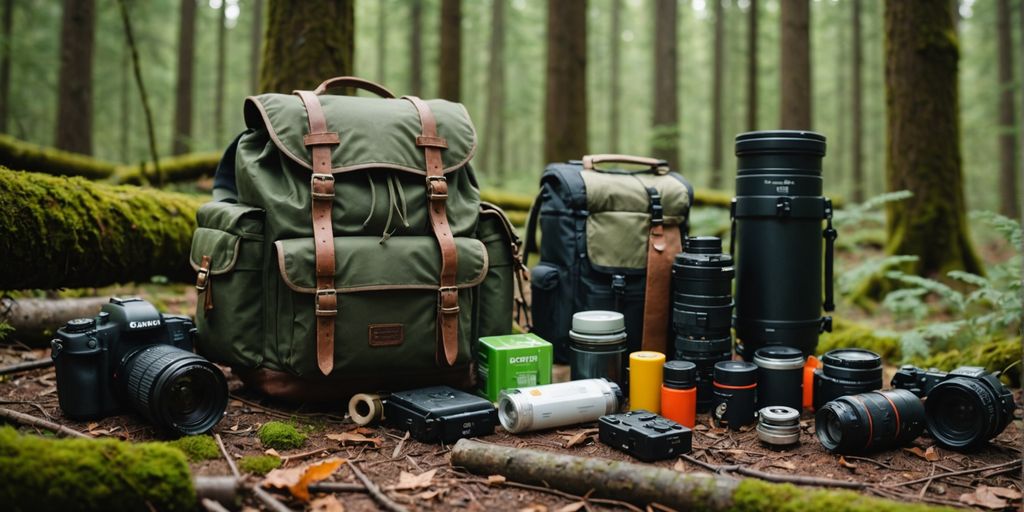When you’re exploring the great outdoors, it’s crucial to be prepared. You might not need all of these items on a short trip, but having them can make a big difference if things go wrong. The Mountaineers, an outdoor organization, created a list of ten essential survival items. Over time, this list has evolved into a set of systems that help you stay safe and sound in the wilderness.
Key Takeaways
- Always carry a reliable navigation tool to avoid getting lost.
- A good light source is essential for visibility in the dark.
- Sun protection helps prevent sunburn and other sun-related issues.
- A first aid kit can be a lifesaver in case of injuries.
- Extra food and water are crucial for staying nourished and hydrated.
1. Navigation
When you’re out in the wild, knowing your location and how to get to safety is crucial. Navigation tools like maps and compasses are essential survival gear. Even experienced hikers can lose their way if they’re not careful.
Consider these items for your navigation system:
- Map
- Compass
- Phone with GPS
- GPS device
- Personal Locator Beacon (PLB)
- Satellite messenger
Always familiarize yourself with your equipment before heading out. Check everything before you leave to ensure it works properly.
For short day hikes, a simple paper map or your phone with GPS and downloaded maps of the area might be enough. Just make sure you have more than enough battery life. If you’re going on a longer trip, a GPS device or a satellite messenger can be a lifesaver.
2. Illumination
When you’re out in the wild, having a reliable source of light is crucial. A flashlight or headlamp can be a lifesaver if you find yourself lost or stuck after dark. It’s not just about seeing where you’re going; it’s also about signaling for help and staying safe from potential hazards.
Consider these options for your illumination needs:
- Coast G23: A handy mini backup pen and area light.
- Fenix E12: A compact flashlight weighing less than an ounce.
- PETZL Tikka: A 300 Lumen headlamp.
- Black Diamond Storm: A powerful 400 Lumen headlamp.
- Nitecore NU25: An ultra-light headlamp weighing just 53 grams.
Always carry extra batteries and a backup light source. You never know when you might need them.
Whether you’re on a day hike or a longer adventure, having the right lighting can make all the difference. Don’t underestimate the importance of being prepared with proper illumination.
3. Sun Protection
When you’re out in the wild, sun protection is crucial to avoid serious sunburn, sun poisoning, and even snow blindness. It’s not just for beach days or summer hikes; you need to be prepared for any situation where you might be exposed to the sun for longer than expected.
Good options for sun protection essentials include:
- Sunglasses: Look for ones with UVA and UVB protection. If you’re in snowy areas, consider glacier glasses. Always have an extra pair in your group.
- Sunscreen: Choose a formula that blocks both UVA and UVB rays. Go for at least SPF 30 and reapply as needed.
- Hat: A full-brim hat can protect your face and neck.
- Clothing: Lightweight, sweat-wicking clothes that cover as much skin as possible are best.
Even in warm weather, it’s smart to wear clothes that cover your skin. Add a full-brim hat to protect your face and neck.
Double-check your sun protection gear before heading out. You never know when you might need to spend extra time in the sun.
4. First Aid
A well-stocked first aid kit is crucial for handling minor emergencies. Small cuts and abrasions can lead to serious infections if not treated properly. Your kit should include a variety of bandages, antiseptic wipes, and antibacterial ointment.
Essential Items
- Bandages (variety)
- Antiseptic spray
- Antibacterial ointment
- Tweezers
- Medical tape
- Gauze pads
- Scissors
- Pain relievers
- Gloves
Why It’s Important
Having a first aid kit keeps you and your group safe in emergencies. It allows you to address injuries quickly and effectively, preventing complications.
In a major disaster, you are your own medical aid until help arrives. This can be days, so be prepared.
Additional Tips
- Learn basic first aid skills.
- Regularly check and restock your kit.
- Keep your kit in an easily accessible location.
By being prepared with a comprehensive first aid kit, you can handle unexpected injuries and keep everyone safe.
5. Tools
When you’re out in the wild, having the right tools can make all the difference. Tools help you get stuff done. Imagine trying to cut paracord without a knife—it’s nearly impossible!
Here are some essential tools you should consider:
- Knife: A good knife is indispensable for food prep, first aid, and even cleaning a fish.
- Multi-tool: This is like a Swiss Army knife on steroids. It includes a knife, saw, pliers, and more. It’s useful for everything from building a shelter to fixing a broken backpack.
- Repair Kit: Whether it’s for your tent, bike, or clothes, a small repair kit can save the day.
- Activity-Specific Tools: Depending on your adventure, you might need specialized tools like a bike tool kit.
Always keep a pocket knife or multi-tool within reach. They’re handy for so many tasks, from fixing your car to opening a bottle of soda.
6. Fire Starter
A reliable fire starter is a must-have in any survival kit. Fire provides warmth, light, and a way to cook food, making it essential for survival in the wild. Here are some key items to consider for your fire-starting system:
- Waterproof matches
- Lighter
- Ferro rod
- Firestarters
- Stove
It’s wise to have at least three different methods to start a fire. This way, if one fails, you have backups. For example, you could carry matches, a lighter, and a striker. Additionally, pack some tinder and other aids to help get the fire going. Store everything in waterproof containers to keep them dry and ready to use.
Always be prepared with multiple fire-starting options. This ensures you can start a fire even in challenging conditions.
Some top-rated fire starters include:
| Item | Features |
|---|---|
| Gerber Gear Fire Starter | Compact design, adjustable lanyard |
| Wolf and Grizzly Fire Set | Best ferro rod |
| Greenspark Firestarters | Ideal for fire pits |
| Exotac Fire Starters | Great for camping |
Remember, fire is not just for warmth and cooking. It can also be used for signaling for help. So, make sure your fire-starting kit is always ready and accessible.
7. Shelter
In any survival situation, having a reliable shelter is crucial. It protects you from harsh weather, predators, and other dangers. Exposure to the elements can be deadly. Here are some essential items to consider for your shelter system:
- Emergency bivy
- Tarp
- Space blanket
- Tent
- Sheet of plastic
A tent is often the best option, but it can be bulky and heavy. A good alternative is to carry materials like a tarp or space blanket, which can be used with natural resources to create a shelter. A tarp, in particular, is versatile and can be a literal lifesaver in almost any emergency survival situation.
Your essential shelter should be a place where you can get out of the wind and rain while trapping some body heat. Always have a backup emergency shelter, especially if you plan on venturing away from your main camp.
8. Extra Nutrition
In a survival situation, having extra nutrition is crucial. Low blood sugar and no energy can make tough situations even harder. It’s important to pack no-cook items that are calorie-dense to keep your energy levels up.
Suggested Items
- Nuts
- Granola bars
- Jerky
- Dried fruit
Why It’s Important
Survival situations are already challenging. Without proper nutrition, your body and mind will struggle even more. Make sure to customize your food choices to your taste or dietary restrictions. Remember, only eat when you have water to help with digestion.
Having a variety of nutrient-packed foods can make a significant difference in your ability to endure and thrive in survival situations.
9. Extra Hydration
When it comes to survival, hydration is essential for human life. While some people may be able to survive for weeks without food, they can only survive a few days at most without water. This makes extra hydration one of the most critical items in your survival kit.
Why It’s Important
- You can potentially survive for weeks without food but just a few days without water.
- Dehydration can lead to poor sleep, and poor sleep can often lead to dehydration.
Essential Items for Hydration
- Extra water: Always carry more water than you think you’ll need.
- Purification tablets: These are lightweight and can purify water from natural sources.
- Survival filter: A practical tool that can filter out harmful bacteria and parasites from water.
In any survival situation, ensuring you have enough water is crucial. The weather conditions in the wilderness can cause fatal dehydration very quickly. Thus, you need a way to compensate for any water loss from your body.
Tips for Staying Hydrated
- Drink small amounts of water regularly rather than large amounts infrequently.
- Avoid alcohol and caffeine as they can dehydrate you.
- Eat hydrating foods like watermelon, cucumber, and oranges to supplement your water intake.
Remember, staying hydrated is not just about drinking water but also about maintaining a balance. Always be prepared with multiple ways to ensure you have access to clean, safe water.
10. Extra Clothing
When you’re out in the wild, having extra clothing can be a lifesaver. Conditions can change unexpectedly, and being prepared with the right clothing can make all the difference. Here are some essential items to consider:
- A jacket
- Hat
- Gloves
- Insulating layer
- Full change of clothes
These items can help you stay warm and dry, which is crucial for avoiding hypothermia. Depending on where and when you’re spending time outside, you should be ready for sudden changes in weather.
Always include some extra clothes, rain gear, and sturdy shoes. If you live someplace extra cold, don’t forget hats, gloves, and winter coats.
Having the right clothing layers can also help you manage your body temperature more effectively. For example, base layers made of wool or synthetic materials can wick away moisture from your skin, keeping you dry and comfortable. Avoid cotton as it retains moisture and can make you cold.
In summary, packing extra clothing is not just about comfort; it’s about survival. Make sure you have the right gear to face any weather conditions you might encounter.
Conclusion
In conclusion, always remember to pack these 10 essential survival items before heading out on any adventure. While you might not need all of them on every trip, having them can be a lifesaver when things go wrong. From navigation tools to extra clothing, each item plays a crucial role in keeping you safe and prepared. So, whether you’re planning a short hike or a long trek, make sure you’re well-equipped. Stay safe and enjoy your time in the great outdoors!


